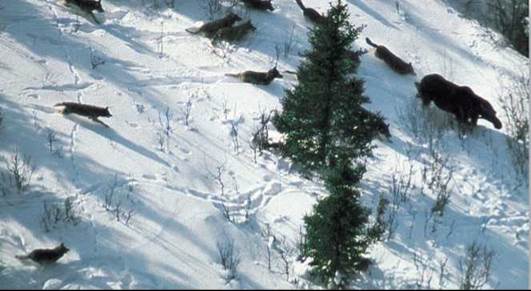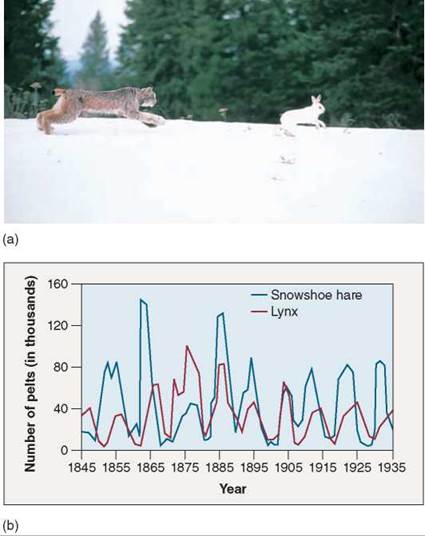THE LIVING WORLD
Unit Eight. The Living Environment
35. Populations and Communities
35.11. Predator-Prey Interactions
In the previous section, we considered parasitism, a symbiotic relationship, a specialized form of predator-prey interaction in which the predator is much smaller than its prey and does not generally kill it. Predation is the consuming of one organism by another, usually of a similar or larger size. In this sense, predation includes everything from a leopard capturing and eating an antelope to a whale grazing on microscopic ocean plankton.
In nature, predators often have large effects on prey populations. Some of the most dramatic examples involve situations in which humans have either added or eliminated predators from an area. For example, the elimination of large carnivores from much of the eastern United States has led to population explosions of white-tailed deer, which strip the habitat of all edible plant life within their reach. Similarly, when sea otters were hunted to near extinction on the western coast of the United States, populations of sea urchins, a principal prey item of the otters, exploded. Appearances, however, sometimes can be deceiving. On Isle Royale in Lake Superior, moose reached the island by crossing over ice in an unusually cold winter and multiplied freely there in isolation. When wolves later reached the island by crossing over the ice, naturalists widely assumed that the wolves were playing a key role in controlling the moose population. More careful studies have demonstrated that this is not in fact the case. The moose that the wolves eat are, for the most part, old or diseased animals that would not survive long anyway. In general, the moose are controlled by food availability, disease, and other factors rather than by the wolves (figure 35.23).

Figure 35.23. Wolves chasing a moose—what will the outcome be?
On Isle Royale, Michigan, a large pack of wolves pursue a moose. They chased this moose for almost 2 kilometers; it then turned and faced the wolves, who by that time were exhausted from running through chest-deep snow. The wolves lay down, and the moose walked away.
Predator-Prey Cycles
Population cycles are characteristic of some species of small mammals, such as lemmings, and they appear to be stimulated, at least in some situations, by their predators. Ecologists have studied cycles in hare populations since the 1920s (figure 35.24). They have found that the North American snow-shoe hare, Lepus americanus, follows a “10-year cycle” (in reality, it varies from 8 to 11 years). Its numbers fall 10-fold to 30-fold in a typical cycle, and 100-fold changes can occur. Two factors appear to be generating the cycle: food plants and predators.

Figure 35.24. A predator-prey cycle.
(a) A snowshoe hare being chased by a lynx. (b) The numbers of lynxes and snowshoe hares oscillate in tune with each other in northern Canada. The data are based on numbers of animal pelts from 1845 to 1935. As the number of hares grows, so does the number of lynxes, with the cycle repeating about every 10 years. Both predators (lynxes) and available food resources control the number of hares. The number of lynxes is controlled by the availability of prey (snowshoe hares).
Key Learning Outcome 35.11. Prey populations can be affected by their predators. Some populations of predators and their prey oscillate in a cyclic manner.